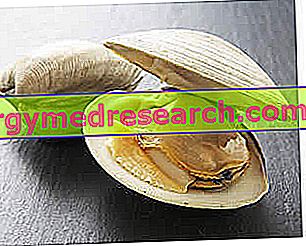What are
Clams are molluscs belonging to the Bivalve Class and to the Veneridae (or Veneridae ) family; the term "clams" groups together numerous genera and about 400 different species throughout the world.

Geographical distribution
In the Mediterranean Sea basin - between the indigenous and the introduced ones - there are about thirty species of clams. Obviously, as anticipated, the term "clams" is rather generic and among the various creatures the characteristic aspects of anatomical nature are clearly distinguishable; however, all the clams are joined by the presence of a "hinge" that joins the two valves, physically composed of three hinge-divergent teeth.
The species of native clams most appreciated at the national level are (binomial nomenclature - Genus and Species): Venus verrucosa or sea truffle, Callista chione or fasolaro, Tapes decussatus or clam, Paphia aurea and Paphia romboides or longoni e (more important from production point of view) Chamelea gallina or Adriatic clam and Tapes philippinarum or Filipino clam.
To obtain a good compromise between correctness of classification and common language, from now on "clams" we will only understand the Adriatic clam, the clam and the Filipino clam (of indo-Pacific origin).
Biology
The various species of clams have very different characteristics and habits of life. In particular, the Adriatic clam colonizes only sandy and sandy-muddy bottoms off the coasts, forming natural banks on depths that oscillate between less than 1m and 12-15m; on the contrary, the clam and the Philippine clam are found near the coasts, inside the lagoons and in the transitional waters (brackish), on sandy-muddy or muddy bottoms and very shallow bathymetric.
The clams are endowed with robust shells with a more or less ovoid or triangular elliptical shape; these are composed of two equal valves and dorsally articulated by means of a hinge; in correspondence of this anatomical region, the clams present the umbo, or an element of which the organism grows and from which it is possible to observe (on the valve surface) some concentric streaks called "growth". The opening and closing of the valves is guaranteed by two adductor muscles (front and rear). The external coloring of the clams is variable, as is the superficial ornamentation (lines, lattices, flammules and radial bands).
Clams are filter-type organisms; they feed on phytoplankton and organic substances in suspension by means of two siphons (one inhalant and the other exhalant) which aspirate and expel the liquid. NB . Just looking at the siphons it is possible to distinguish the Philippine clam from the true one; while the Filipina has two adherent and coupled siphons, the true one has completely separated them.
The gills of the clams, positioned after the siphons, are rich in eyelashes and, in addition to acting as respirators, they capture the nutrients from the water bringing them to the mouth; the latter is provided with palps which select the useful particles from those of waste, which are then expelled from the exhaling siphon as if they were faeces. The clams move thanks to the foot which, dilating and contracting due to blood pressure, allows the body to sink even up to 15cm below the sediment.
The clams are organisms with separate sexes (gonocorica), with external fertilization and rarely hermaphrodites; the gonads are represented by a whitish mass, homogeneous, soft and placed around the digestive tract. The sexual maturity of the clams is reached after about 12 months of life and the fecundity increases with the size of the animal; the reproductive period is generally placed between the end of spring and the beginning of summer with the liberation and fertilization of millions of eggs. From the egg of the clams originates a planktonic larva (15-17 days in duration) which at the end of the metamorphosis process settles in the seabed and passes to the benthic phase.
To obtain a satisfactory comparison of the two most important clam species for the national economy, below we will summarize some of the biological and ecological characteristics of the Adriatic clam and the Philippine clam.
| Species | Tapes philippinarum | Chamelea gallina |
| Trade name and vernacular terms | Filipino clam, Filipino "clam" clam, Manila clam, etc. | Adriatic clam, poverassa, bibarassa, lupine, bevarassa, peverassa, arsella, cocciola, cappa gallina, porrazza, cuppe etc. |
 |  | |
| Description | Shell ovoid-shaped with a marked lattice, consisting of growth striae and radial elements. The coloring is very variable and often brightly decorated (chromatic polymorphism). The interior varies from white to yellow to purple. The maximum size can be over 80mm; common are specimens of length between 30 and 45mm. | Robust shell, with a sub-triangular-elliptical shape, with low concentric ribs. The color goes from albino white to various shades of gray, often with zigzagging reddish-brown ornaments. The interior varies from white-yellowish to purple purple. Although they can exceed 50mm in length and 8 years of age, adult specimens between 25 and 30mm are common. |
| Habitat | It lives in brackish environments on sandy-muddy lagoon and coastal depths at low depths. | It lives mainly on fine coastal sands of the infra-coast to a depth of 12-15m. |
| Distribution | Today it can be considered ubiquitous. Of Indo-Pacific origin it was introduced in Italy in March 1983. | It is found throughout the Mediterranean, in the Black Sea, and in the Atlantic (from Norway to Morocco). |
Fishing and Venericulture
Clams are harvested by: managed fishing, venericulture and free-access fishing (mainly exploited in illegal trade).
Managed fishing exploits the natural shoals of clams and respects their management criteria (periodization, sampling methods, limited areas, etc.). NB : Clam fishing is also necessary for the collection of "seeds" for venericity (otherwise obtained by controlled reproduction in "schiuditoio").
Venericulture is a form of farming that exploits the cyclical periods of sowing, fattening and harvesting on concessionary areas that are considered safe from a hygienic-sanitary point of view.
The methods of fishing for clams are different:
- Manual: by hand (on very low depths, it is the only one given to non-professionals), rake with long handle for boat, rake with short handle manual
- Mechanics: towing razor, crampon, vibrating dredger, hydraulic dredger, rake or long and short pump etc.
Unfortunately, the advent of mechanization in the removal of clams (which took over the last 50 years) is significantly weakening the population density of this bivalve; to this intensive practice are then added: natural disasters and poaching. The latter, carried out by means of the turbo-blowers in very little water (fishing of the Philippine clam and of the verace), has a disastrous impact also on the reproductive cycle of some fish that, deposing ONLY in a few centimeters of water, do not have the possibility to preserve the integrity of the eggs and ensure the continuation of the species.
Hygienic aspects
Clams are bivalve molluscs and, as filter feeders, they can be the vehicle for bacteria and viruses that affect humans.
| Nutritional composition of Clams - Reference values of the INRAN Food Composition Tables | ||||||||||||||||||||||||||||||||||||||||||||||||||||||||||||||||||||||||
 | ||||||||||||||||||||||||||||||||||||||||||||||||||||||||||||||||||||||||
Nutritional values (per 100 g of edible portion) | ||||||||||||||||||||||||||||||||||||||||||||||||||||||||||||||||||||||||
| ||||||||||||||||||||||||||||||||||||||||||||||||||||||||||||||||||||||||
If at the time of purchase, the safety guarantee mark and the relative traceability are present on the sales tag, the clams can be defined SAFE.
On the contrary, procuring from sources of dubious origin significantly increases the risk of contracting even very serious diseases such as salmonellosis ( Salmonella paratyphi ), typhoid ( Salmonella typhi ), hepatitis (virus A), cholera ( Vibrio cholerae ) etc. Obviously, cooking can destroy the microbial load of clams but, to minimize the risk of infection, it is advisable to buy ONLY certified and guaranteed products.
Clams must be preserved by refrigeration but NEVER for more than a day; it is possible to try to keep them alive by immersing them in sea water or in demineralized water but added with sodium chloride. The clams must always be well closed, otherwise they could already be dead and have a very high microbial load.
Nutritional characteristics
Clams are a food of animal origin, therefore they contain cholesterol. Fortunately, the portion of saturated fat is quantitatively very limited.
However, not being in possession of more precise data inherent to the lipid profile of the clams, it is advisable to consume them with sporadic frequency (for example once a week) and with medium portions not excessive (on average 400g per head, which correspond to 100g of part edible). Furthermore, as they are bivalve organisms that filter sea water, the clams contain high amounts of sodium, a mineral salt to be taken in moderation and above all in the event of blood pressure changes. NB : Clams are potentially allergenic foods and should not be used during pregnancy or lactation.
Clams contain few lipids, traces of carbohydrates and a good amount of high biological value proteins; the energy supply is extremely reduced.
No information is available regarding the salt and vitamin content of clams (except for retinol equivalents).
Clams in the Kitchen
In the video, our Personal Cooker illustrates the basic rules to follow for cleaning and cooking clams, and then preparing one of the simplest dishes: the Pescatora Clams. Familiar with this shellfish, the next step will be to prepare some tasty noodles of fresh homemade pasta with clams.
Clean and Cook the Clams - Vongole alla Pescatora
X Problems with video playback? Reload from YouTube Go to Video Page Go to Video Recipes Section Watch the video on youtubeFamiliar with this shellfish, the next step will be to prepare some tasty noodles of fresh homemade pasta with clams.
Discover other tempting recipes based on clams.
Pasta with clams
X Problems with video playback? Reload from YouTube Go to Video Page Go to Video Recipes Section Watch the video on youtubeBibliography:
- The clams dealto Adriatico. Between environment and market - G. Trevisan - FrancoAngeli



